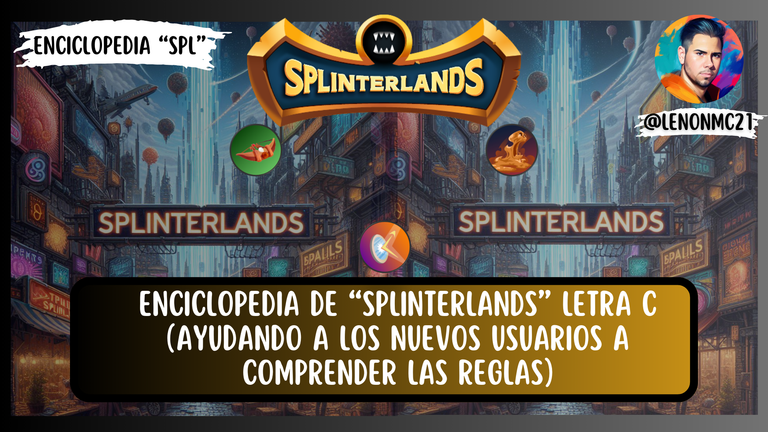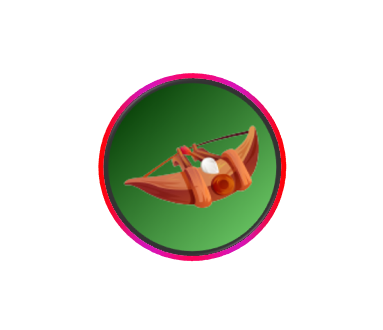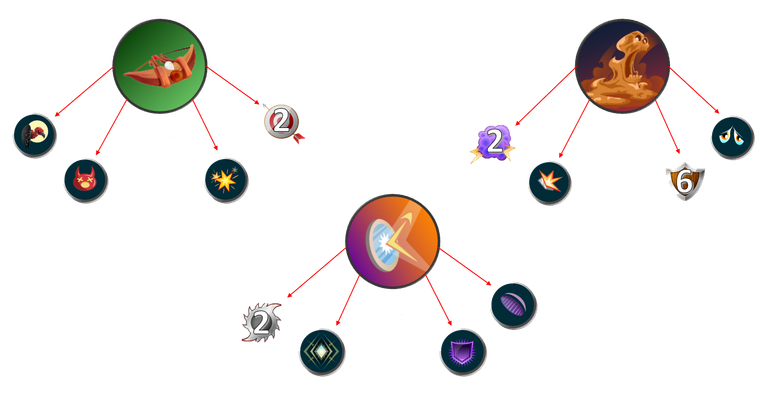
Cover created in Canva

Ya hace aproximadamente 3 meses que no les traigo la continuación de lo que es la “Enciclopedia de Splinterlands”, la cual, está enfocada en enseñarles de manera sencilla y sin complicaciones, como funcionan las reglas en el juego, aunque, quizás algunos se estarán preguntando porque esto es tan importante, pues, déjenme decirles que conocer las reglas del juego, les otorga un 60% de probabilidades de ganar cada partida que juegan, el resto del porcentaje, se reparte en un 30% para las habilidades que poseen las cartas y un 10% que tiene que ver con nuestra capacidad para crear estrategias efectivas de acuerdo a esos conocimientos.
Es por eso que, en esta oportunidad, quiero continuar con la “Enciclopedia de Splinterlands”, enfocada en esta ocasión en las reglas del juego, ya que más adelante estaré hablando sobre otros temas importantes para agregar a la “Enciclopedia”, en todo caso y para continuar, esta vez les traeré la (Letra C), en pocas palabras, las reglas que comienzan por esta vocal, además y como siempre, estaré explicando en detalle los efectos de las mismas y con qué tipo de habilidades podrían ir mejor, esto para que comiencen a internalizar las combinaciones que existen, estoy seguro de que si aprenden esto, podrán discernir fácilmente que jugar en cada situación de juego, solo quedando a merced de su creatividad y de por supuesto, el rival que enfrenten.
Así que, les pido que lean esta publicación hasta el final, ya que estará cargada de mucho aprendizaje para todos, aunque enfocado para los más nuevos en el ecosistema, ya que, los que ya tienen tiempo jugando, deberían de conocer todos estos conceptos, en especial porque todo esto se aprende es con la “Practica”, así que, para ello, estaré abarcando los siguientes puntos:
- Explicación detallada de los efectos de las reglas (Close Range, Corrosive Fog y Counterspell)
- ¿Cuáles son las mejores “Habilidades” para jugar con estos “Conjuntos de Reglas”?

Explicación detallada de los efectos de las reglas (Close Range, Corrosive Fog y Counterspell)

En esta sección explicare todo lo relacionado a los efectos que poseen estas reglas, sean en el campo de batalla o en su defecto si es que afecta directamente a los monstruos, sin embargo, los conjuntos de reglas de este post son algo peculiares, ya que son muy distintas y se enfocan en modos de juegos diferentes, no se preocupen que al final entenderán todo lo que estoy comentando, aunque lo más importante de todo esto, es que “Teóricamente” aprenderán cómo funcionan cada una de ellas, pero, solo la practica hará que se aprendan cada uno de estos efectos, tranquillos, les daré algunos “Tips” para acelerar el proceso, pero, sin más dilaciones, vamos con los efectos:

Close Range

Close Range es una regla muy fácil de entender y de manejar a mi manera de entender el juego, básicamente el único ataque que deberíamos tomar en cuenta para jugar con esta regla es solo el ataque de “Rango”, sin embargo, si solo incluimos en nuestro equipo monstruos con este tipo de ataque, seguramente tendríamos problemas, ya que, el efecto no hace un cambio radical en la jugabilidad, pero ¿Cuál es su efecto?:
- El efecto de esta regla es darles la oportunidad a las cartas con el tipo de ataque de “Rango”, atacar desde la primera posición, en pocas palabras, donde comúnmente se sitúa el famoso “Tanque de Batalla”. Básicamente este es todo el efecto, pero ¿Por qué comento que por sí solo no tendría un cambio radical?
Pues porque, a menos que este en el campo la regla “Going the Distance”, donde estamos obligados a jugar con solo cartas del tipo de ataque de “Rango”, en condiciones normales si jugamos de esta manera, nuestras probabilidades de ganar podrían estar en grave peligro, pero, lo que si podemos hacer es combinar esfuerzos con otros tipos de ataque, ya que, con esta regla en juego, la “Estrategia” que pensemos es imperativa para tener éxito.

Corrosive Fog

Esta regla fue agregada al juego este mismo año si mas no recuerdo, en todo caso, es una de las reglas nuevas que se han introducido al juego, la cual, esta muy bien pensada, ya que su efecto o bien nos puede traer graves problemas dependiendo de cómo juguemos; o en su defecto, podríamos poner en serios aprietos al oponente que nos enfrente, aunque, todo depende siempre de las reglas que se combinen con esta, aunque, si la tenemos sola, podría ser mucho más fácil de manejar de lo que se cree.
- Con respecto a su efecto, esta regla causa daño directo a los puntos de “Escudo” que posee cada carta, en este caso, remueve de la armadura -1 punto, sin embargo, el punto que la hace interesante es que, en cada ronda, pierda 1 punto de armadura máxima, esto quiere decir que, si por ejemplo, una carta posee +4 puntos de escudo y en esta ronda pierde 1, le quedarían 3, pero, si por ejemplo una carta quiere reparar ese punto de armadura de nuestro lado del campo, no podrá hacerlo, esto es lo interesante, ya que, vuelve inservible la posibilidad de plantear una estrategia de protección solo con “Escudo”.
Como dije, esta regla es interesante debido a que los puntos de armadura no se pueden reparar, no funcionara, por lo que, de este modo, jugar con “Armadura” no es que no sea útil, de hecho, a pesar de los efectos aun puede retrasar a la ofensiva del rival, pero, no debemos solo depender de la “Defensa” en base a los puntos de escudo, esto es lo que debemos tener clatro, antes de jugar y armar nuestros equipos.

Counterspell

Esta es una de las reglas que los amantes del tipo de ataque “Mágico” odian, la razón es que, es bastante peligroso jugar si es que se decide jugar solo con ataques “Mágicos”, sin embargo, tampoco es complicada de manejar, de hecho, cuando sepan su efecto en breve, se darán cuenta de que es muy sencillo, pero, depende de cómo queramos afrontar a nuestro oponente y tratar de discernir con que tipo de ataque iría el rival, esto es primordial, tomando en cuenta que es muy poco probable que se juegue con el tipo de ataque “Mágico”.
- Con respecto a su efecto es muy sencillo, básicamente lo que hace es otorgarles a todas las cartas en el campo la habilidad llamada “Magic Reflect”, la cual, lo que hace es reflejar parte del daño recibido a la carta del rival, en pocas palabras, si el ataque posee +2 puntos de ataque mágico, este mismo recibirá -1 punto de daño mágico en sus puntos de vida.
Por supuesto, hay más detalles detrás de los que son los efectos de “Magic Reflect”, en el sentido de que, podemos tener una “Defensa” contra esto, o también aumentar el daño de devolución del ataque, pero, estas son cosas que irán aprendiendo con la practica y el estudio, ya que como dije al principio, el juego involucra también en un gran porcentaje el conocer todas las habilidades existentes en el juego y adicional la estrategia que le apliquemos para que todo pueda engranar.

¿Cuáles son las mejores “Habilidades” para jugar con estos “Conjuntos de Reglas”?

En esta sección mostrare esquemas de como podemos combinar estas reglas con las diferentes habilidades existentes en el juego, debo destacar que, como el post ya es lo suficientemente largo, compartiré los esquemas mas algunos comentarios adicionales sobre estos, pero, quisiera ver en los comentarios de que forman esas reglas podrían engranar con las habilidades mostradas en dichos esquemas, igualmente en otra oportunidad estaré completando lo que es esta información en conjunto con una de las nuevas reglas introducidas al juego bajo la “Letra B”, la cual, ya mostré, en todo caso y sin mas dilación, a continuación los esquemas:

En los siguientes esquemas pueden observar las habilidades y/o estadísticas que poseen cada una de las “Reglas de Batalla” o aquellas que funcionan mucho mejor en las mismas, si prestan atención a cada una, verán que estos aspectos pueden ayudar a jugar a favor de la regla o en contra de ella, tomando en cuenta lo que podría jugar nuestro oponente, algo que con la practica serán capaces de manejar, sin embargo, un ejemplo claro de esto, es que, si por ejemplo en “Counterspell” es perjudicial usar ataques mágicos, lo más probable es que se use “Cuerpo a Cuerpo o Rango”, de este modo, ya sabemos que podría jugar nuestro oponente.

Consideraciones Finales

Espero que este post de continuación de la “Enciclopedia de Splinterlands” les haya gustado, aun queda mucho por enseñar en la misma, así que no se despeguen, en este caso, ya tenemos las letras (A, B Y C), sin embargo, como dije anteriormente, sacare una continuación especial agregando una de las reglas nuevas a la “Letra B” y la explicación detallada de los esquemas presentados en esta edición de la (Letra C). Al final les dejare los enlaces a las 2 primeras partes de esta “Enciclopedia”.

Nos vemos en el "Campo de Batalla"

It's been about 3 months since I last brought you the continuation of the "Splinterlands Encyclopedia", which is focused on teaching you in a simple and uncomplicated way, how the rules work in the game, although, perhaps some of you are wondering why this is so important, well, let me tell you that knowing the rules of the game, gives you a 60% chance of winning every game you play, the rest of the percentage is divided into 30% for the skills possessed by the cards and 10% for the abilities of the cards, Let me tell you that knowing the rules of the game, gives you a 60% chance of winning every game you play, the rest of the percentage is divided into 30% for the skills that the cards have and 10% that has to do with our ability to create effective strategies according to that knowledge.
That's why, in this opportunity, I want to continue with the "Splinterlands Encyclopedia", focused this time on the rules of the game, since later I will be talking about other important topics to add to the "Encyclopedia", in any case and to continue, this time I will bring you the (Letter C), in short, the rules that begin with this vowel, in addition and as always, I will be explaining in detail the effects of the same and with what kind of skills could go better, this so that you begin to internalize the combinations that exist, I am sure that if you learn this, you can easily discern what to play in each game situation, only being at the mercy of your creativity and of course, the opponent you face.
So, I ask you to read this publication until the end, as it will be loaded with a lot of learning for everyone, although focused for the newest in the ecosystem, since, those who already have time playing, should know all these concepts, especially because all this is learned is with "Practice", so, for this, I will be covering the following points:
- Detailed explanation of the effects of the rules (Close Range, Corrosive Fog and Counterspell).
- What are the best "Skills" to play with these "Rule Sets"?

Detailed explanation of the effects of the rules (Close Range, Corrosive Fog and Counterspell).

In this section I will explain everything related to the effects that these rules have, whether on the battlefield or if it directly affects the monsters, however, the sets of rules in this post are somewhat peculiar, as they are very different and focus on different game modes, don't worry that at the end you will understand everything I'm talking about, although the most important of all this, is that "Theoretically" you will learn how each of them work, but, only practice will make you learn each of these effects, relax, I will give you some "Tips" to speed up the process, but, without further delay, let's go with the effects:

Close Range

Close Range is a very easy rule to understand and manage in my way of understanding the game, basically the only attack that we should take into account to play with this rule is only the "Range" attack, however, if we only include in our team monsters with this type of attack, we would surely have problems, since the effect does not make a radical change in the gameplay, but what is its effect?
- The effect of this rule is to give cards with the "Range" attack type the opportunity to attack from the first position, in short, where the famous "Battle Tank" is commonly placed. Basically this is the whole effect, but why do I say that by itself it would not have a radical change?
Well, unless the "Going the Distance" rule is in place, where we are obliged to play with only "Range" attack type cards, under normal conditions if we play this way, our chances of winning could be in serious danger, but, what we can do is to combine efforts with other attack types, since, with this rule in play, the "Strategy" we think is imperative to succeed.

Corrosive Fog

This rule was added to the game this year if I remember, in any case, it is one of the new rules that have been introduced to the game, which is very well thought out, since its effect can either bring us serious problems depending on how we play; or failing that, we could put in serious trouble the opponent who faces us, although, everything always depends on the rules that are combined with this one, although, if we have it alone, it could be much easier to handle than you think.
- Regarding its effect, this rule causes direct damage to the "Shield" points that each card has, in this case, it removes -1 point from the armor, however, the point that makes it interesting is that, in each round, it loses 1 point of maximum armor, this means that, if for example, a card has +4 shield points and in this round it loses 1, this means that, if for example, a card wants to repair that armor point on our side of the field, it will not be able to do it, this is what is interesting, a card has +4 points of shield and in this round loses 1, it would have 3 left, but, if for example a card wants to repair that point of armor on our side of the field, it will not be able to do so, this is what is interesting, since it makes useless the possibility of proposing a protection strategy only with "Shield".
As I said, this rule is interesting because armor points cannot be repaired, it will not work, so, in this way, playing with "Armor" is not that it is not useful, in fact, despite the effects it can still slow down the opponent's offense, but, we should not only rely on "Defense" based on shield points, this is what we should have clear, before playing and building our teams.

Counterspell

This is one of the rules that lovers of the "Magic" type of attack hate, the reason is that, it is quite dangerous to play if you decide to play only with "Magic" attacks, however, it is not complicated to handle, in fact, when you know its effect shortly, you will realize that it is very simple, but, it depends on how we want to face our opponent and try to discern what type of attack the opponent would go with, this is paramount, taking into account that it is very unlikely to play with the "Magic" type of attack.
- With respect to its effect is very simple, basically what it does is to give all the cards in the field the ability called "Magic Reflect", which, what it does is to reflect part of the damage received to the opponent's card, in short, if the attack has +2 points of magic attack, it will receive -1 point of magic damage in its life points.
Of course, there are more details behind the effects of "Magic Reflect", in the sense that we can have a "Defense" against this, or also increase the return damage of the attack, but these are things that you will learn with practice and study, because as I said at the beginning, the game also involves a large percentage of knowing all the existing skills in the game and additional strategy that we apply so that everything can mesh.

What are the best "Skills" to play with these "Rule Sets"?

In this section I will show schemes of how we can combine these rules with the different existing skills in the game, I must emphasize that, as the post is already long enough, I will share the schemes plus some additional comments on these, but, I would like to see in the comments how these rules could mesh with the skills shown in these schemes, also in another opportunity I will be completing this information together with one of the new rules introduced to the game under the "Letter B", which, I already showed, in any case and without further delay, here are the schemes:

In the following diagrams you can observe the skills and/or statistics that have each of the "Battle Rules" or those that work much better in the same, if you pay attention to each one, you will see that these aspects can help to play in favor of the rule or against it, taking into account what our opponent could play, something that with practice you will be able to handle, however, a clear example of this, is that, if for example in "Counterspell" it is harmful to use magic attacks, it is most likely to use "Melee or Range", thus, we already know what our opponent could play.

Final Considerations

I hope you liked this post of continuation of the "Encyclopedia of Splinterlands", there is still much to teach in it, so stay tuned, in this case, we already have the letters (A, B and C), however, as I said before, I will release a special continuation adding one of the new rules to the "Letter B" and the detailed explanation of the schemes presented in this edition of the (Letter C). At the end I will leave the links to the first 2 parts of this "Encyclopedia".
See you on the battlefield

Here is the direct link to my latest posts and the link to my Profile
Visit my website
 |  |
| ¿Que nos espera con las nuevas actualizaciones en "Splinterlands" para el (Formato Salvaje)? [ES-EN] | Reporte y desempeño en las “Batallas de Brawl” con (Shield of Glory KOG) + Últimos Ciclos |



If you are new, I invite you to register in this LINK


Proud Member of "Shield of Glory".

Posted Using InLeo Alpha

